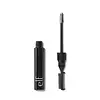What's inside
What's inside
 Key Ingredients
Key Ingredients

 Benefits
Benefits

 Concerns
Concerns

 Ingredients Side-by-side
Ingredients Side-by-side

Water
Skin ConditioningAlcohol Denat.
AntimicrobialHydroxyethyl Acrylate/Sodium Acryloyldimethyl Taurate Copolymer
Emulsion StabilisingPolyacrylate-2 Crosspolymer
Glycerin
HumectantTromethamine
BufferingSorbitol
HumectantAcrylates Copolymer
Panthenol
Skin ConditioningPolysorbate 60
EmulsifyingSorbitan Isostearate
EmulsifyingButylene Glycol
HumectantCitric Acid
BufferingAllantoin
Skin ConditioningEthylhexylglycerin
Skin ConditioningSodium PCA
HumectantSodium Lactate
BufferingArginine
MaskingAspartic Acid
MaskingPropylene Glycol
HumectantPCA
HumectantBiotin
AntiseborrhoeicPelvetia Canaliculata Extract
Skin ProtectingLaminaria Digitata Extract
Skin ProtectingGlycine
BufferingAlanine
MaskingSerine
MaskingThreonine
Valine
MaskingIsoleucine
Skin ConditioningProline
Skin ConditioningHistidine
HumectantPhenylalanine
Masking1,2-Hexanediol
Skin ConditioningCaprylyl Glycol
EmollientBenzoic Acid
MaskingMyristoyl Pentapeptide-17
Skin ConditioningSodium Benzoate
MaskingPhenoxyethanol
PreservativeWater, Alcohol Denat., Hydroxyethyl Acrylate/Sodium Acryloyldimethyl Taurate Copolymer, Polyacrylate-2 Crosspolymer, Glycerin, Tromethamine, Sorbitol, Acrylates Copolymer, Panthenol, Polysorbate 60, Sorbitan Isostearate, Butylene Glycol, Citric Acid, Allantoin, Ethylhexylglycerin, Sodium PCA, Sodium Lactate, Arginine, Aspartic Acid, Propylene Glycol, PCA, Biotin, Pelvetia Canaliculata Extract, Laminaria Digitata Extract, Glycine, Alanine, Serine, Threonine, Valine, Isoleucine, Proline, Histidine, Phenylalanine, 1,2-Hexanediol, Caprylyl Glycol, Benzoic Acid, Myristoyl Pentapeptide-17, Sodium Benzoate, Phenoxyethanol
Water
Skin ConditioningCeteareth-30
CleansingGlycerin
HumectantAcrylates Copolymer
Paraffin
PerfumingMicrocrystalline Wax
Emulsion StabilisingButylene Glycol
HumectantHydrogenated Polyisobutene
EmollientParaffinum Liquidum
EmollientEuphorbia Cerifera Wax
Copernicia Cerifera Cera
EmollientPvp
Emulsion StabilisingPalmitic Acid
EmollientStearic Acid
CleansingAlcohol
AntimicrobialPhenoxyethanol
PreservativePolysorbate 80
EmulsifyingAminomethyl Propanol
BufferingHydroxypropyl Methylcellulose
Emulsion StabilisingXanthan Gum
EmulsifyingTocopheryl Acetate
AntioxidantEthylhexylglycerin
Skin ConditioningDisodium EDTA
Hydrolyzed Wheat Protein
Skin ConditioningHydrolyzed Soy
Skin ConditioningHydrolyzed Soy Protein
HumectantHydrolyzed Corn Protein
Skin ConditioningSodium Chloride
MaskingWater, Ceteareth-30, Glycerin, Acrylates Copolymer, Paraffin, Microcrystalline Wax, Butylene Glycol, Hydrogenated Polyisobutene, Paraffinum Liquidum, Euphorbia Cerifera Wax, Copernicia Cerifera Cera, Pvp, Palmitic Acid, Stearic Acid, Alcohol, Phenoxyethanol, Polysorbate 80, Aminomethyl Propanol, Hydroxypropyl Methylcellulose, Xanthan Gum, Tocopheryl Acetate, Ethylhexylglycerin, Disodium EDTA, Hydrolyzed Wheat Protein, Hydrolyzed Soy, Hydrolyzed Soy Protein, Hydrolyzed Corn Protein, Sodium Chloride
 Reviews
Reviews

Ingredients Explained
These ingredients are found in both products.
Ingredients higher up in an ingredient list are typically present in a larger amount.
Acrylates Copolymer is used as a film-forming agent and texture enhancer.
After applied, Acrylates Copolymer forms a thin film cover that helps skin feel more soft. It can help sunscreens become more water-resistant.
It is also used to make a product more thick.
Learn more about Acrylates CopolymerButylene Glycol (or BG) is used within cosmetic products for a few different reasons:
Overall, Butylene Glycol is a safe and well-rounded ingredient that works well with other ingredients.
Though this ingredient works well with most skin types, some people with sensitive skin may experience a reaction such as allergic rashes, closed comedones, or itchiness.
Learn more about Butylene GlycolEthylhexylglycerin (we can't pronounce this either) is commonly used as a preservative and skin softener. It is derived from glyceryl.
You might see Ethylhexylglycerin often paired with other preservatives such as phenoxyethanol. Ethylhexylglycerin has been found to increase the effectiveness of these other preservatives.
Glycerin is already naturally found in your skin. It helps moisturize and protect your skin.
A study from 2016 found glycerin to be more effective as a humectant than AHAs and hyaluronic acid.
As a humectant, it helps the skin stay hydrated by pulling moisture to your skin. The low molecular weight of glycerin allows it to pull moisture into the deeper layers of your skin.
Hydrated skin improves your skin barrier; Your skin barrier helps protect against irritants and bacteria.
Glycerin has also been found to have antimicrobial and antiviral properties. Due to these properties, glycerin is often used in wound and burn treatments.
In cosmetics, glycerin is usually derived from plants such as soybean or palm. However, it can also be sourced from animals, such as tallow or animal fat.
This ingredient is organic, colorless, odorless, and non-toxic.
Glycerin is the name for this ingredient in American English. British English uses Glycerol/Glycerine.
Learn more about GlycerinPhenoxyethanol is a preservative that has germicide, antimicrobial, and aromatic properties. Studies show that phenoxyethanol can prevent microbial growth. By itself, it has a scent that is similar to that of a rose.
It's often used in formulations along with Caprylyl Glycol to preserve the shelf life of products.
Water. It's the most common cosmetic ingredient of all. You'll usually see it at the top of ingredient lists, meaning that it makes up the largest part of the product.
So why is it so popular? Water most often acts as a solvent - this means that it helps dissolve other ingredients into the formulation.
You'll also recognize water as that liquid we all need to stay alive. If you see this, drink a glass of water. Stay hydrated!
Learn more about Water